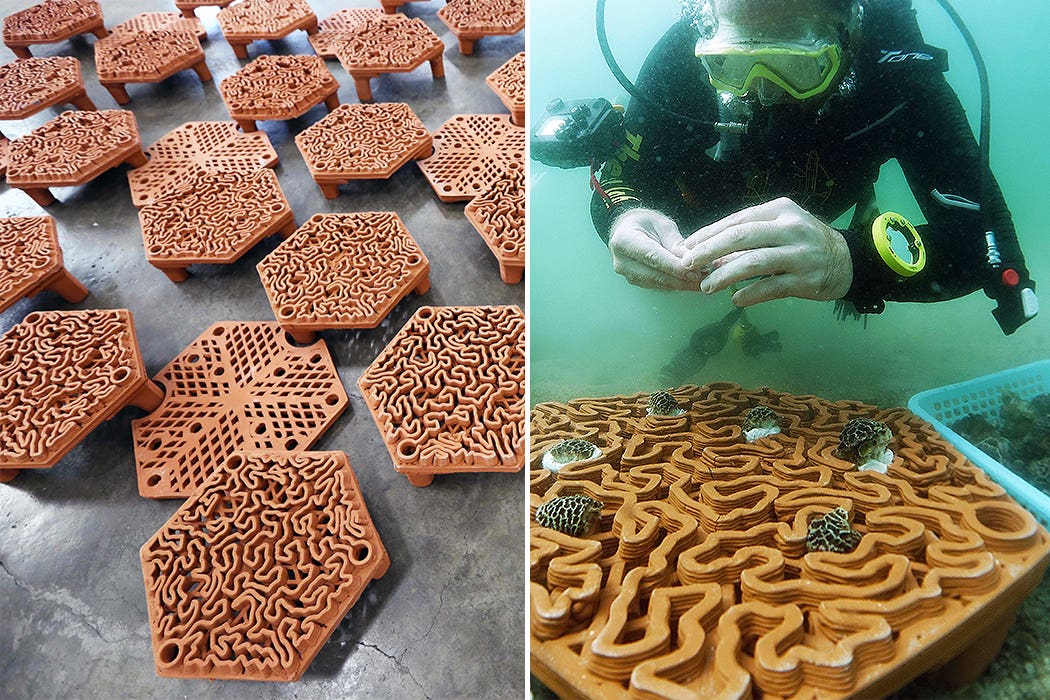These 3d Printed Terracotta Tiles Along Hong Kong’s Coast Are Designed To Revive Marine Coral Life
Hong Kong saw an 80% decline in the coral population in Double Island, Sai Kung, over the past decade

[Aug. 5, 2020: Yanko Design]
Coral reefs are one of the most beautiful natural wonders of the world and I can say that from my personal diving experience – there is a whole colorful world that thrives underwater and we must protect it because they support more species per unit area than any other marine environment! Coral presence has rapidly declined all over the world, especially in the last decade so Hong Kong-based marine scientists and architects have created terra-cotta tiles to help rebuild and give corals a fighting chance against climate change. This is a crucial leap for ocean restoration projects!
Hong Kong saw an 80% decline in the coral population in Double Island, Sai Kung, over the past decade and that drove the team to come up with a solution that would not only help that region but also the rest of the world that was blessed with corals. The team from Swire Institute of Marine Science (SWIMS) of the University of Hong Kong (HKU) and its Robotic Fabrication Lab of the faculty of architecture worked together to 3D print terra-cotta tiles that will act as artificial reefs. The result is a mesmerizing, organic swirl of line and negative space that reads like a burnt orange topographic map—and mimics the natural patterns of the coral itself. Why terra-cotta? It’s highly porous with “nice surface micro-texture” for marine organisms to latch on to, says team member Dave Baker, and an eco-friendly alternative to conventional materials such as cement or metal, the HKU team says.
The team 3D printed terra-cotta clay into the reef tile pattern and fired it to 2,057 degrees Fahrenheit to produce the 128 tiles so far. Each tile is almost two feet in diameter. The team placed the reef tiles seeded with coral fragments over about a 430-square-foot area across three sites within Hoi Ha Wan Marine Park in Hong Kong this past July and will monitor it for the next two years. The designs can also be specific to the environment and underwater conditions where they are placed; for instance, the team designed these tiles to prevent sedimentation buildup, a major problem in Hong Kong waters. The tiles interlock organically which enables the team to keep expanding when needed without disturbing existing settings. It gives the corals lots of nooks and crannies to anchor onto. Manmade or artificial reefs help restore lost coral populations by reintroducing an environment amenable to regrowth—and they’ve been made of everything from purposefully submerged shipwrecks to cement sculptures because corals aren’t picky, they just want to grow!
Like these kind of stories? Get The Brighter Side of News' newsletter.
The robotic 3D printing process offers unique advantages in the design and production of artificial reefs, it makes production easier and more efficient, by allowing the team to create large pieces in a short amount of time. It also enables the team to create tiles with different designs and functions that could be specific to certain corals and help in accelerating their growth.
“Though these tiles could be produced with other methods, such as making a double-sided mold, it would be quite complex to do since the design of the tile is very three-dimensional,” Lange says. “3D printing offers the advantage to produce objects and parts much more cost-effectively. But the most powerful advantage of it is that it could print each object with a different design without increasing the cost.”
The team from Swire Institute of Marine Science (SWIMS) of the University of Hong Kong (HKU) and its Robotic Fabrication Lab of the faculty of architecture worked together to 3D print terra-cotta tiles that will act as artificial reefs. With time the team will use different designs in the next iteration to figure out how they affect the species..... Read More
Joseph Shavit
Head Science News Writer | Communicating Innovation & Discovery
Based in Los Angeles, Joseph Shavit is an accomplished science journalist, head science news writer and co-founder at The Brighter Side of News, where he translates cutting-edge discoveries into compelling stories for a broad audience. With a strong background spanning science, business, product management, media leadership, and entrepreneurship, Joseph brings a unique perspective to science communication. His expertise allows him to uncover the intersection of technological advancements and market potential, shedding light on how groundbreaking research evolves into transformative products and industries.
